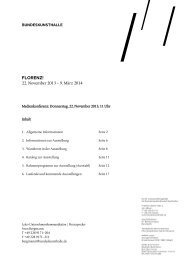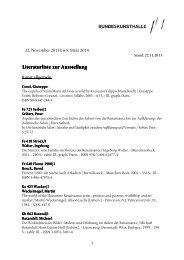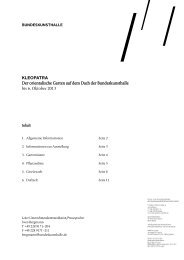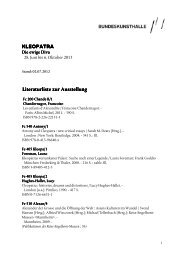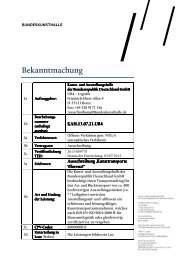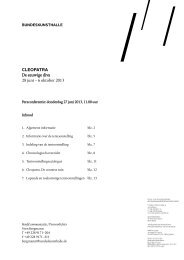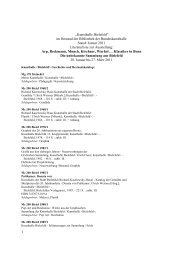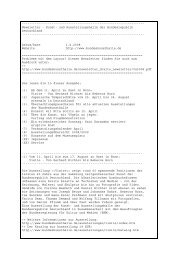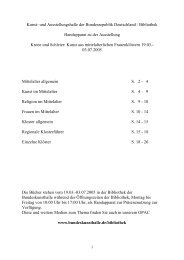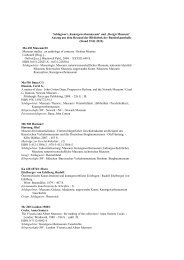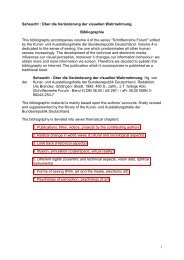Peoples through space and time Archaeology in Germany 09.05 ...
Peoples through space and time Archaeology in Germany 09.05 ...
Peoples through space and time Archaeology in Germany 09.05 ...
Create successful ePaper yourself
Turn your PDF publications into a flip-book with our unique Google optimized e-Paper software.
numerous new facilities <strong>in</strong> the old settlement areas have been discovered <strong>and</strong> exam<strong>in</strong>ed by<br />
archaeologists.<br />
As a result, the previous <strong>in</strong>terpretation of these four-sided entrenchments as separated holy sites,<br />
conta<strong>in</strong><strong>in</strong>g a temple structure <strong>and</strong> deep shafts for sacred offer<strong>in</strong>gs, could not be confirmed. Rather, an<br />
earlier <strong>in</strong>terpretation was given greater weight <strong>in</strong> that these sites represent re<strong>in</strong>forced estates. The fact<br />
that such estates were established <strong>in</strong> areas that were heretofore considered to be poorly settled throws<br />
light on new aspects of the Celtic civilization’s economy.<br />
On the Threshold to High Culture<br />
From an archaeological perspective, the entire late Celtic region between France <strong>and</strong> Hungary presents a<br />
predom<strong>in</strong>antly homogenous picture, characterized by the so-called Oppida Civilization. It is<br />
dist<strong>in</strong>guished by re<strong>in</strong>forced cities accord<strong>in</strong>g to the Mediterranean model, luxury <strong>and</strong> everyday goods <strong>in</strong><br />
series production, foreign trade <strong>and</strong> co<strong>in</strong>age, as well as a conformity <strong>in</strong> cult practices <strong>and</strong> religious<br />
ideas.<br />
Celtic culture <strong>in</strong> Southern <strong>Germany</strong> decl<strong>in</strong>ed gradually, its decl<strong>in</strong>e is considered to have been brought<br />
about by the <strong>in</strong>vasion of Germanic tribes from the low mounta<strong>in</strong>s <strong>in</strong> the 1 st century B.C. Archaeological<br />
research has proven that, <strong>in</strong> comparison, the region west of the Rh<strong>in</strong>e was cont<strong>in</strong>uously populated from<br />
the Celtic to Roman era.<br />
The Celtic City of Manch<strong>in</strong>g<br />
20 of the 380 hectares encompass<strong>in</strong>g the fort hill of Manch<strong>in</strong>g near Ingolstadt have been exam<strong>in</strong>ed by<br />
archaeologists, who have identified its development from a small open settlement from 300 B.C. to a<br />
political <strong>and</strong> economic center.<br />
Technological progress <strong>in</strong> the late Iron Age is characterized by a high level of specialization <strong>in</strong><br />
craftsmanship. Written records, weights, measurements <strong>and</strong> diverse imports from the Mediterranean, as<br />
well as an ordered circulation of money, give testimony to the urban character of the late Celtic<br />
civilization at the threshold of high culture.<br />
Up until 25 years ago, the Celtic city of Manch<strong>in</strong>g’s demise was considered to have come about as an<br />
outcome of war due to the Roman <strong>in</strong>vasion of the Danube. Today, however, it is considered to have<br />
come about already by 50 B.C. <strong>through</strong> gradual economic decl<strong>in</strong>e.<br />
11c<br />
Glauberg – Chiefta<strong>in</strong> Seat <strong>and</strong> Sacred Shr<strong>in</strong>e<br />
Between 1994 <strong>and</strong> 1997 a unique early Celtic monumental ensemble from the 5 th century B.C. was<br />
excavated at Glauberg, north-east of Frankfurt on the Ma<strong>in</strong> River. This sensational archaeological<br />
discovery, its importance go<strong>in</strong>g far beyond <strong>Germany</strong>’s borders, throws new light on the world of the<br />
Celtic rul<strong>in</strong>g elite.<br />
On the Glauberg plateau an early Celtic chiefta<strong>in</strong> seat once stood, at the foot of which a monumental<br />
burial hill measur<strong>in</strong>g 48 meters <strong>in</strong> diameter was erected. A so-called ‘processional way’, 350 meters<br />
long <strong>and</strong> 10 meters wide, led <strong>in</strong> a direct l<strong>in</strong>e from the plateau to the tomb. The surround<strong>in</strong>g area is<br />
encompassed by entrenchment works measur<strong>in</strong>g hundreds of meters <strong>in</strong> length.<br />
On the edge of the burial hill further spectacular discoveries were made: a life-size stone statue of a<br />
Celtic warrior <strong>and</strong> the broken pieces of three other statues. They all stood at one <strong>time</strong> with<strong>in</strong> the sacred<br />
area, which served as a place of ancestor worship.<br />
The sacred shr<strong>in</strong>e <strong>and</strong> the burial hill were situated at the center of a sacred area that extended <strong>in</strong>to the<br />
l<strong>and</strong>scape <strong>in</strong> un-dreamt of proportions. As such, the site at Glauberg proves to have been an important<br />
site <strong>in</strong> the early Celtic world, despite its geographically marg<strong>in</strong>al location.<br />
Chiefta<strong>in</strong> Grave 1<br />
The timber-l<strong>in</strong>ed chamber of Chiefta<strong>in</strong> Grave 1 was dug 2,5 meters-deep <strong>in</strong>to the ground <strong>and</strong> protected<br />
from theft by a stone pack<strong>in</strong>g.<br />
Because of the earth’s pressure, all of the artifacts except for a spouted bronze vessel <strong>in</strong> the burial<br />
chamber were compressed <strong>in</strong>to a few cen<strong>time</strong>ters-thick layer. These were salvaged <strong>in</strong> blocks <strong>and</strong> later<br />
prepared under laboratory conditions, archaeologically analyzed <strong>and</strong> conserved.<br />
15




